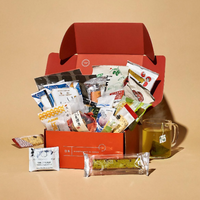8 Irresistible Types of Asian Shaved Ice You Need to Try
Long before the days of modern refrigeration and instant ice makers, people across Asia found a way to beat the summer heat with one of the most refreshing desserts ever created: shaved ice. With roots tracing back to the 11th century, this chilly delicacy has evolved into countless variations, each shaped by its country’s flavors, ingredients, and culinary traditions.
Originally, shaved ice was a luxury—an icy indulgence reserved for the elite or the lucky few with access to ice during the hottest months. But thanks to advancements in technology, improved access to trade, and cultural exchange, this dessert has become a beloved summer staple across the continent.
So, what exactly is shaved ice? The answer varies wildly from one country to the next. Some are light and fruity, others are rich and creamy. Some are served in towering glasses, while others are eaten on a stick. Let’s explore eight delicious and culturally rich versions of Asian shaved ice—and maybe inspire your next summer dessert craving.
1. Japan: Kakigori

When summer arrives in Japan, so does kakigori, a traditional shaved ice dessert that blends simplicity with elegance. You'll spot it everywhere—from vibrant summer festivals like Kyoto’s Gion Matsuri to quiet neighborhood shops.
Unlike coarse snow cones, kakigori features ultra-fine ice shavings that practically melt in your mouth. The base may be just water-based ice, but the magic lies in the flavors and toppings.
Popular flavors include:
-
Sweet strawberry syrup
-
Bitter and earthy matcha (green tea)
-
Bright lemon
-
Tropical mango
For a more indulgent treat, kakigori is often layered with toppings like:
-
Sweetened condensed milk
-
Azuki red bean paste
-
Dango (chewy rice flour dumplings)
-
Fresh fruit or jelly
It’s a perfect example of Japanese minimalism combined with creativity, offering a cooling experience that’s both nostalgic and luxurious.
2. Taiwan: Tshuah-ping (Tsua Bing / Baobing)

In Taiwan, shaved ice goes by several names—tsuah-ping, tsua bing, or baobing—and it’s a national treasure when it comes to summer desserts.
Taiwanese shaved ice is known for its abundance of vibrant, juicy toppings and the option to tailor your dessert exactly to your liking. Unlike kakigori, Taiwanese ice is often topped more generously, resulting in a colorful, multi-textured dish.
Common toppings include:
-
Fresh seasonal fruits (like mango, kiwi, or lychee)
-
Sweetened condensed milk or syrup
-
Mung beans or red beans
-
Jelly cubes
-
Taro balls or grass jelly
One beloved variant, xuehua bing, uses frozen milk instead of water to create a creamier consistency. It’s a heavenly fusion of flavor and texture that balances sweetness with the natural juiciness of fresh ingredients.
3. South Korea: Bingsu (Bingsoo)

Creamy, decadent, and undeniably Instagram-worthy—bingsu (or bingsoo) is South Korea’s answer to shaved ice. It’s a dessert that has evolved from traditional red bean bingsu (patbingsu) into a creative canvas for toppings and textures.
What sets bingsu apart is its milk-based ice, which gives it a rich, velvety mouthfeel right from the first bite. Instead of relying solely on syrups, bingsu emphasizes generous and diverse toppings.
Some modern bingsu toppings include:
-
Popping boba
-
Cheesecake cubes
-
Crushed cookies
-
Matcha or chocolate sauce
-
Fruit jellies
-
Ice cream or frozen yogurt
From classic to contemporary, bingsu is as much a visual spectacle as it is a delicious treat. You’ll find it in cafés all over Seoul and beyond, often served in giant bowls meant to be shared.
4. Philippines: Halo-Halo

One of the most iconic and extravagant shaved ice desserts in Asia, halo-halo (literally "mix-mix" in Tagalog) is a Filipino masterpiece of texture and flavor. It’s served in a tall glass that proudly displays its rainbow layers of ingredients.
Halo-halo is not just a dessert—it’s a celebration. Each bite brings a surprise, thanks to the wide variety of components packed inside.
Typical ingredients include:
-
Sago (similar to tapioca pearls)
-
Nata de coco (coconut gel)
-
Jackfruit, sweetened banana (saba), and langka
-
Sweet beans (azuki and white)
-
Shaved ice topped with evaporated milk
And the crowning glory? A scoop of rich purple ube (purple yam) ice cream or creamy leche flan. Dive in with a spoon—or a rolled wafer—and don’t forget to follow its namesake: mix, mix!
5. India: Ice Gola (Chuski / Baraf Gola)

If you’re walking the streets of Mumbai during a heatwave, chances are you’ll come across a street vendor selling ice gola—India’s take on shaved ice.
Unlike most of the other entries on this list, ice gola is served on a stick, making it one of the most portable versions. It's similar in concept to a popsicle but made by tightly packing shaved ice into a cylindrical shape and then soaking it in brightly colored syrups.
Popular syrup flavors include:
-
Kala khatta (a tangy blackberry-like flavor)
-
Rose
-
Orange
-
Kachcha aam (raw mango)
It’s sometimes finished with a dash of salt or masala spice to add a tangy, savory kick—making it a complex and thrilling flavor experience.
6. Indonesia: Es Campur

In Indonesia, es campur ("mixed ice") is a cold and sweet celebration of color and variety, typically sold by street vendors and at markets during the hot months or the fasting season of Ramadan.
This dessert has more in common with halo-halo and bingsu due to its layered ingredients and sweet condensed milk drizzle. The mixture of shaved ice and toppings creates a refreshing blend that’s both hydrating and satisfying.
Toppings can include:
-
Coconut meat
-
Avocado
-
Jackfruit
-
Black grass jelly
-
Red tapioca pearls
-
Syrups and condensed milk
Es campur is proof that with the right toppings, a simple base of ice can be transformed into a work of art.
7. Turkey: Bici Bici

Venturing westward, Turkey offers a unique twist on shaved ice with bici bici, a lesser-known gem from the country’s southern regions like Adana and Mersin.
Unlike others that are fruit-forward or dairy-heavy, bici bici features a starch-based jelly. Made from cooked starch, this jelly is cooled, cubed, and then layered with finely shaved ice.
The entire dish is then topped with:
-
Rose water for floral fragrance
-
Bright-colored syrup
-
A dusting of powdered sugar
Light, subtly sweet, and with a texture all its own, bici bici offers a delicate and refreshing alternative to the fruitier variations found in East and Southeast Asia.
8. Thailand: Namkhaeng Sai (Wan Yen)

Thailand’s take on shaved ice, namkhaeng sai (also known as wan yen), is all about customization and fun. Unlike most desserts where toppings go on top, here, they go on the bottom—setting the stage for a flavorful excavation.
Start with a bowl and choose from a wide array of toppings like:
-
Cubed sweet potato
-
Pineapple chunks
-
Pumpkin
-
Jackfruit
-
Red beans
-
Basil seeds
-
Cubed bread
-
Grass jelly
Pile a mound of shaved ice on top, drizzle with vibrant syrup (and maybe some condensed milk), and dive in. Each spoonful reveals a new combination of flavors and textures, making it an interactive treat as much as a tasty one.
Craving Shaved Ice Yet?
If this tour of Asian shaved ice has you craving something cold, you’re not alone. Fortunately, you don’t have to hop on a plane to enjoy these frosty delights. At Bokksu, we bring the world of authentic Japanese snacks—and shaved ice-worthy toppings—straight to your doorstep.
From chewy gomadare mochi to citrusy yuzu konjac jelly, our premium, handpicked treats can turn your homemade kakigori, bingsu, or any other frozen creation into a five-star dessert experience.
At Bokksu, we proudly source high-quality Japanese snacks from local makers who craft their products with care and tradition. When you subscribe, you’re not just treating yourself—you’re helping to sustain small businesses and preserve Japan’s rich culinary heritage.
So go ahead—cool off, explore bold new flavors, and take your tastebuds on an unforgettable summer journey across Asia.
Author Bio

































